Couching in its most basic form is among the easier embroidery stitches. Essentially, the couching stitch is just a little straight stitch taken over some other thread (or ribbon or wire) to hold it down. Couching with the simple straight couching stitch can be decorative when couching a filled area, because you can alternate the placement of the couching stitches to make designs over whatever thread is being couched.
But you can also approach couching from a different angle: consider it simply as tying down another thread (or ribbon or wire) with any stitch, besides just a straight stitch, and suddenly, many possibilities open up!
For today’s Stitch Play, I’ll show you some different takes on couching. You can apply these (and any others your imagination can drum up) when couching one thread, multiple threads at a time, a beautiful ribbon, or even metal threads.
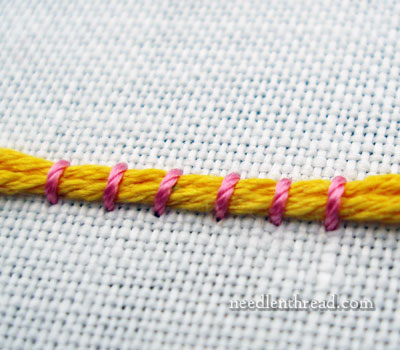
This is your basic couching stitch. The purpose of those little pink straight stitches is to hold down those two bright yellow strands of embroidery thread.
Unless you’re trying to achieve a very random, somewhat fun-n-funky look to your stitching, couching always looks best when the stitches are uniform in size and evenly spaced. Sometimes, it’s hard to achieve uniformity in spacing. Depending on how you’re using the couching (along a line of thread or as a filling) and the amount of contrast between the couched thread and the couching thread, if the spacing is slightly off, it might or might not be noticeable! For example, if you have a high contrast between your couched thread (let’s say it’s white) and your couching thread (we’ll say it’s red), the occasionally misplaced stitch will show up a lot clearer! But if you’re couching a red thread down and using the same color thread to couch the red the thread down (or a shade close to it), uneven spaces won’t be as easily noticed. So, the point: the more contrast between the two threads, the more important it is to mind your spacing!
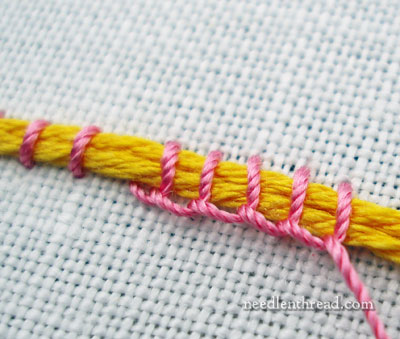
But who says couching stitches always have to be simple straight stitches? Did you know you can use a basic blanket stitch to couch down another thread? Using blanket stitch to couch another thread can be quite a decorative take on couching. The blanket stitch will form a twisted line on one side of the couched thread. Imagine this worked over a flat ribbon – it could be very pretty, which a nice contrast in texture between the flatness of the ribbon and the twisted edge formed by the blanket stitch.
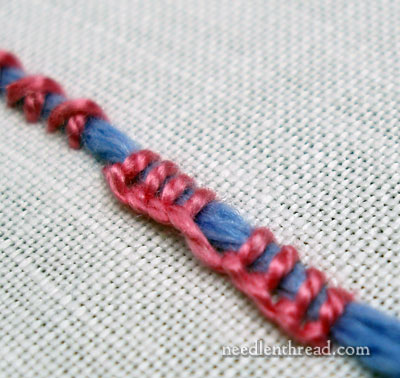
For even more variation, you can even group your blanket stitches different ways, in groups of two or three or four, with longer spaces between each group.
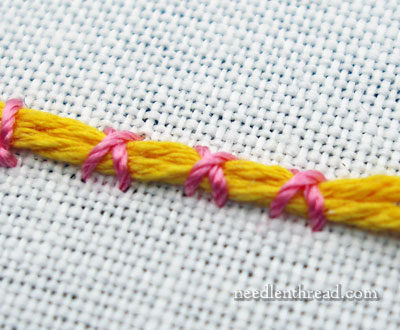
Little cross stitches work quite well for couching down other threads! And they can make quite an effective pattern on an area filled with couching, as they are bolder than regular couching stitches, and the cross stitch can morph into lattice-type designs quite easily, when alternately spaced on each line of couching.
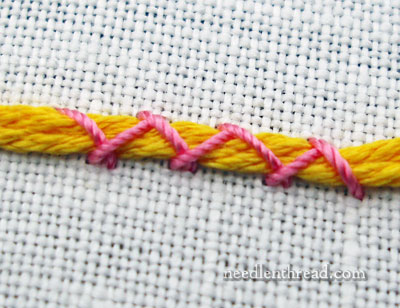
Herringbone stitch works very well to couch down threads. It’s a pretty stitch in its own right, and working it over another thread or ribbon further enhances it.
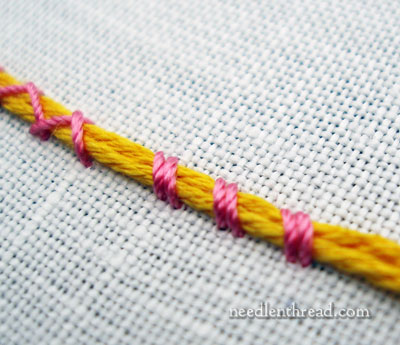
Going back to the simple straight stitch, you can change the look of the straight stitch by grouping two or more straight stitches together and working them on an angle. Imagine filling an area with couched threads, with slanted straight stitches like this, slanting in opposite directions in each row. You could work up some interesting filling patterns this way.
So, you can see that couching can go beyond the straight stitch. Once you start thinking in terms of other stitches to hold down threads, ribbons, or wires on your embroidery, possibilities abound!
Go ahead and have some fun with couching – see what you can come up with! I always think couching is an under-appreciated technique, but once you start messing around with it, you’ll find out how fun and versatile it is.
Stitch Play is a new series on Needle ‘n Thread, in which we explore different stitches, techniques, and combinations in photo tutorials. If you have a stitch or technique you’d like to see worked out in Stitch Play, feel free to leave a comment below and let me know! I’ll see if I can work something up for you!







Mary, do you have any photos or tutorials on couching ribbon? Since it is flat, I think there is a technique to keeping stitches loose enough so as not to curl it. Ribbon embroidery is new to me and something I’m interested in learning. Thanks in advance for your response. Regards, Linda Trent
Hi, Linda – the key to coaching ribbon is to work just beyond the edge of the ribbon, so that the stitches lie on top of it, but don’t crowd the edges of the ribbon. Then it will lie flat. So, take your stitches up and down in the fabric just beyond the ribbon’s edge slightly, rather than right at the edge of the ribbon. I’ll see if I can work something up to show it in pictures… – MC
Hi Mary! So glad to see your reminder about how effective couching can be if we stretch our imaginations a bit. Referring to Linda’s ribbon question, sometimes it’s easier to work the “couching” stitches first, then weave the ribbon thru the stitched area using a tapestry needle/bodkin & plunge the ends. It saves frustration with fine/thin ribbons that can get fiddly.
G’day Mary,
I’ve certainly underestimated couching, so thank you for lifting this stitch to it’s rightful place in my estimation.
Cheers, Kath
As always an excellent post:-)
Couching is next on my to-learn list.
Aha, a stitch I’ve done before. My embroidery skills are very limited. But even with couching, you’ve taken it to an whole new level. I never thought of using different stitches over the cord to make it prettier. That brings me to my next thought:
You mention using any other stitches our imagination can drum up. Is there any way you can do a tutorial on “imagination.” I seem to be lacking that. LOL
Oh, this is perfect! I am starting a project where I decided to use couching stitch, and now I have lots more ideas to ponder. Thanks!!
I learn SO MUCH from your blog – thank you, thank you!
As an aside, your photography is amazing.
Mary, I can visualize that (for couching ribbon) and it seems easy enough.
The information and all the tools/techniques you provide are priceless!! Thank you so much for sharing your knowledge and time so freely!
Wow! What a bunch of wonderful ideas! And they are so simple that you wonder why you didn’t think of them yourself! Duh! Thanks so much for sharing!
Thanks for the ideas on variations! Is the couching stitch thread usually smaller than the couched thread? Or is that something else that can be played around with for more variations – larger/smaller, different fiber, etc?
Hi, Gail – you can play around with that, actually. You can work up all kinds of variations with the crouching thread and with the thread that’s being couched, to add interest and variety. It also depends on what type of stitching you’re doing. Crazy quilting, for example, opens up all kinds of possibilities, as does free style surface embroidery. I think the key is just trying out combinations to see what works and what fits whatever project you’re working on. That’s the fun thing about surface embroidery, isn’t it? The possibilities are practically endless!
MC
Thanks, Mary, You are profoundly appreciated by so many folks from all over the world! Your clear instructions, videos, techniques, tips, reviews, and dazzling projects for impeccable stitching are absolutely astonishing.
Your giving, helpful and caring heart is amazing and you greatly bless me every single day! You are the absolute best of the best!
Golly shucks, Penny, thank you for your kind comment! 🙂
Wow! I never would have thought about blanket stitch or cross stitching for couching, but then my total lack of imagination is well documented. Thanks so much for these ideas. I’ll definitely bookmark this for future reference. I am glad to see you have “Stitch Play” as a tag so we can look them all up. This is very useful!
That’s a clever way to do ribbon couching and one I didn’t think of. Thanks, for the suggestion. I found a picture of ribbon couching in one of the books that Mary recommends (The Embroider’s Handbook by Margie Bauer). Because of Mary’s blog, my passion for embroidery has been renewed.
Mary,
I was astounded with the second photo in “Stitch Play Index,” second photo of Couching.
Back in 1957 I was fresh out of Air Force electronic school and at my first duty station, Charleston AFB. Zip Ties had not come about and aircraft manufacturers secured their wire runs (often 200 wires, each wire with its own unique number, in bundles) with wax cord and the couch stitch. Of couse, we knew it simply as lacing. When wiring modifications were required a the cord had to be cut, it was replaced according to exact specifications. The quality control inspctor used his tape measure to see that it was so.
I’m new at this embroidery business and I wish to thank you for the tutorial information you offer on your website and newsletters. Without your help I would still be looking for a hobby.
Scott Laughlin
McKinney, Texas
I found your article interesting but I am stitching ‘Jacobean Tangle’ by Hazel Blomkamp from Stitch magazine and it mentions TWISTED COUCHING. Would it be possible to describe it for me please? Thank you in advance. x
Mary,
I have found many sites that show HOW to do couching, but I can’t find any that show couching on more than just threads or large yarns. I would like to see samples of small lettering, not tiny, but small like to put on Christmas ornaments in hoops. What could be used that would stand out but not be too difficult to do?
Thank you
June Arnold
Also I do like your site very much. A lot to learn from you. Thanks
Could you demo underside couching?
Thanks
Hi, Cindy! It’s on my list! 🙂
I often refer to your website or YouTube videos for answers to my stitching questions. Like you I learned embroidery as a child. Now that I’m older I am exploring other needlework techniques and enjoying the creative process. Thank you for all your help.
Thanks, Melinda! I’m glad you find Needle ‘n Thread helpful! 🙂
I have an embroidered picture which calls for double couching all around borders of sails how do I do it instructions are not very clear do I do two rows of single couching all around
Loved the different ideas presented here! – you opened up a whole range of creative possibilities, not only for embroidery but use with border work in some of my calligraphy, drawing and notecard applications. Thank you for putting fun and innovation into what so many other sites made seem arduous and complicated.